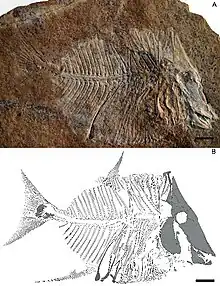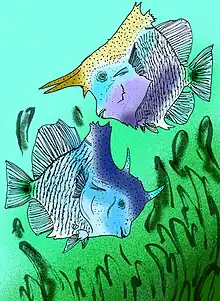| Scalacurvichthys Temporal range: Cenomanian, | |
|---|---|
 | |
| Image and camera lucidia drawing of the holotype (SMNK-PAL. 8613) | |
| Scientific classification | |
| Domain: | Eukaryota |
| Kingdom: | Animalia |
| Phylum: | Chordata |
| Class: | Actinopterygii |
| Order: | †Pycnodontiformes |
| Family: | †Pycnodontidae |
| Subfamily: | †Pycnodontinae |
| Genus: | †Scalacurvichthys Cawley, and Kriwet 2017 |
| Type species | |
| †Scalacurvichthys naishi John Cawley, and Jürgen Kriwet, 2017 | |
Scalacurvichthys (IPA: [ˌskäːɫäˈkʊrvikʰtʰys]) (meaning "curved scale fish") is an extinct genus of pycnodontine pycnodontiform fish from the Amminadav Formation in West Bank; Palestine. The type species is S. naishi, known from only the holotype which comprises a nearly complete and articulated individual.[1]
Etymology
The generic name, Scalacurvichthys (IPA: [ˌskäːɫäˈkʊrvikʰtʰys]), is derived from the Latin words 'scala' and 'curva'. 'Scala' translates to scale, and 'curva' translates to curved. This is in reference to the raised, anterior-facing first dorsal ridge scale protruding above the skull roof. And the Greek word 'ἰχθύς' which translates to fish. The specific name, naishi (IPA: [ˌneɪʃˈaɪ]), is dedicated to Dr. Darren Naish whom is a prominent palaeontologist and the founder of the vertebrate palaeozoology blog Tetrapod Zoology, and its accompanying convention TetZooCon.[2][1]
Description
Scalacurvichthys is known only from the holotype, SMNK-PAL. 8613, which was described in 2017 by Cawley, and Kriwet, (2017). The holotype measures at around 12.3 cm (4.8 in) in length. It consists of an almost completely and fully articulated specimen, lacking, however, some cranial and postcranial details due to taphonomic processes. Several morphological elements especially of the postcranial skeleton are preserved and recognizable only as imprints.[1]
Classification
In their phylogenetic analysis, Cawley, and Kriwet, (2017) recovered Scalacurvichthys amongst the pycnodontine grade of pycnodontiforms, most closely related to Oropycnodus, and other pycnodontines. The following cladogram represents the phylogenetic results of a consensus tree, with unordered characters based on modified database of Poyato-Ariza, and Wenz, (2002).[3] The original tree used several members outside of Pycnodontidae, and others outside of Pycnodontiformes as an outgroup, however for simplicity only members of Pycnodontidae are shown below.[1]
| Pycnodontidae |
| ||||||||||||||||||||||||||||||||||||||||||||||||||||||||||||||||||||||||||||||||||||||||||||||||||||||
References
- 1 2 3 4 Cawley, John; Kriwet, Jürgen (14 June 2017). "A new pycnodont fish, Scalacurvichthys naishi gen. et sp. nov., from the Late Cretaceous of Israel". Journal of Systematic Palaeontology. 16 (8): 659–673. doi:10.1080/14772019.2017.1330772. PMC 5849399. PMID 29551954.
- ↑ "TetZooCon". Tetrapod Zoology Podcast. Archived from the original on 23 April 2018. Retrieved 23 April 2018.
- ↑ Poyato-Ariza, Francisco; Wenz, Sylvie (January 2002). "A new insight into pycnodontiform fishes". Geodiversitas. Retrieved 10 November 2023.
